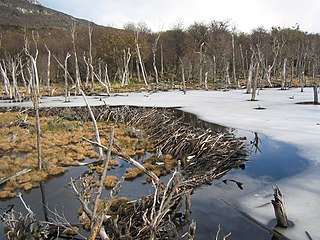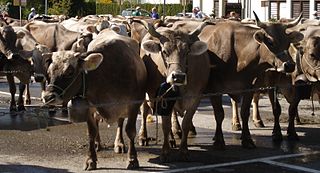
Alaska is a U.S. state in the northwest extremity of North America, just across the Bering Strait from Asia. The Canadian province of British Columbia and territory of Yukon border the state to the east and southeast. Its most extreme western part is Attu Island, and it has a maritime border with Russia to the west across the Bering Strait. To the north are the Chukchi and Beaufort seas—southern parts of the Arctic Ocean. The Pacific Ocean lies to the south and southwest. It is the largest U.S. state by area and the seventh largest subnational division in the world. In addition, it is the 3rd least populous and the most sparsely populated of the 50 United States; nevertheless, it is by far the most populous territory located mostly north of the 60th parallel in North America: its population—estimated at 738,432 by the United States Census Bureau in 2015— is more than quadruple the combined populations of Northern Canada and Greenland. Approximately half of Alaska's residents live within the Anchorage metropolitan area. Alaska's economy is dominated by the fishing, natural gas, and oil industries, resources which it has in abundance. Military bases and tourism are also a significant part of the economy.

Hausa is the Chadic language with the largest number of speakers, spoken as a first language by some 44 million people, and as a second language by another 20 million. "Halshen Hausa" literally means tongue of Hausa. The word "Halshe" is tongue and its cognate in other Afroasiatic languages are lisan (Arabic), lashon (Hebrew), lessana (Syriac), lis (Angas), linso (Ngamo), lusin (Karekare), ri:seŋ (Sayawa), lishim (Bole), lsien (Maltese). The total number of Hausa speakers is estimated at 63 million, according to Ethnologue.
The ancestral language of the Hausa people, one of the largest ethnic groups in Central Africa, Hausa is mostly spoken throughout southern Niger and northern Nigeria. It has developed into a lingua franca across much of Western Africa for purposes of trade.
Indian or Indians refers to people or things related to India, or to the indigenous people of the Americas, or Aboriginal Australians until the 19th century.

Native Americans, also known as American Indians, Indigenous Americans and other terms, are the indigenous peoples of the United States, except Hawaii. There are over 500 federally recognized tribes within the US, about half of which are associated with Indian reservations. The term "American Indian" excludes Native Hawaiians and some Alaska Natives, while Native Americans are American Indians, plus Alaska Natives of all ethnicities. Native Hawaiians are not counted as Native Americans by the US Census, instead being included in the Census grouping of "Native Hawaiian and other Pacific Islander".

An invasive species is a species that is not native to a specific location, and that has a tendency to spread to a degree believed to cause damage to the environment, human economy or human health.

A first language, native language or mother/father/parent tongue, is a language that a person has been exposed to from birth or within the critical period. In some countries, the term native language or mother tongue refers to the language of one's ethnic group rather than one's first language. Children brought up speaking more than one language can have more than one native language, and be bilingual or multilingual. By contrast, a second language is any language that one speaks other than one's first language.

An introduced species is a species living outside its native distributional range, but which has arrived there by human activity, either deliberate or accidental. Non-native species can have various effects on the local ecosystem. Introduced species that become established and spread beyond the place of introduction are called invasive species. The impact of introduced species is highly variable. Some have a negative effect on a local ecosystem, while other introduced species may have no negative effect or only minor impact. Some species have been introduced intentionally to combat pests. They are called biocontrols and may be regarded as beneficial as an alternative to pesticides in agriculture for example. In some instances the potential for being beneficial or detrimental in the long run remains unknown.

Alaska Natives are indigenous peoples of Alaska, United States and include: Iñupiat, Yupik, Aleut, Eyak, Tlingit, Haida, Tsimshian, and a number of Northern Athabaskan cultures. They are often defined by their language groups. Many Alaska Natives are enrolled in federally recognized Alaska Native tribal entities, who in turn belong to 13 Alaska Native Regional Corporations, who administer land and financial claims.

Over 2 billion people speak English. English is the largest language by number of speakers, and the third largest language by number of native speakers. With 300 million native speakers, the United States of America is the largest English speaking country. As pictured in the pie graph below, most native speakers of English are Americans.

Native Hawaiians are the Aboriginal Polynesian people of the Hawaiian Islands or their descendants. Native Hawaiians trace their ancestry back to the original Polynesian settlers of Hawaiʻi. In total, 527,000 Americans consider themselves Native Hawaiian.

An Indian reservation is a legal designation for an area of land managed by a federally recognized Native American tribe under the U.S. Bureau of Indian Affairs rather than the state governments of the United States in which they are physically located. Each of the 326 Indian reservations in the United States is associated with a particular Native American nation. Not all of the country's 567 recognized tribes have a reservation—some tribes have more than one reservation, while some share reservations. In addition, because of past land allotments, leading to some sales to non–Native Americans, some reservations are severely fragmented, with each piece of tribal, individual, and privately held land being a separate enclave. This jumble of private and public real estate creates significant administrative, political, and legal difficulties.

Native plants are plants indigenous to a given area in geologic time. This includes plants that have developed, occur naturally, or existed for many years in an area.

The indigenous peoples of the Americas are the Pre-Columbian peoples of North, Central and South America and their descendants.
Native Americans or Native American may refer to:
Race and ethnicity in the United States is a complex topic both because the United States of America has a racially and ethnically diverse population and because the country has a heavily racist history involving slavery and anti-miscegenation laws. At the federal level, race and ethnicity have been categorized separately.

Lophophora williamsii or peyote is a small, spineless cactus with psychoactive alkaloids, particularly mescaline. Peyote is a Spanish word derived from the Nahuatl, or Aztec, peyōtl [ˈpejoːt͡ɬ], meaning "glisten" or "glistening". Other sources translate the Nahuatl word as "Divine Messenger". Peyote is native to Mexico and southwestern Texas. It is found primarily in the Chihuahuan Desert and in the states of Coahuila, Nuevo León, Tamaulipas, and San Luis Potosí among scrub. It flowers from March to May, and sometimes as late as September. The flowers are pink, with thigmotactic anthers.
Jim Crow laws were state and local laws that enforced racial segregation in the Southern United States. All were enacted in the late 19th and early 20th centuries by white Democratic-dominated state legislatures after the Reconstruction period. The laws were enforced until 1965. In practice, Jim Crow laws mandated racial segregation in all public facilities in the states of the former Confederate States of America, starting in the 1870s and 1880s, and were upheld in 1896, by the U.S. Supreme Court's "separate but equal" legal doctrine for facilities for African Americans, established with the court's decision in the case of Plessy vs. Ferguson. Moreover, public education had essentially been segregated since its establishment in most of the South, after the Civil War (1861–65).

Slavery among Native Americans in the United States includes slavery by Native Americans as well as slavery of Native Americans roughly within the present-day United States. Tribal territories and the slave trade ranged over present-day borders. Some Native American tribes held war captives as slaves prior to and during European colonization, some Native Americans were captured and sold by others into slavery to Europeans, and a small number of tribes, in the late eighteenth and nineteenth centuries, adopted the practice of holding slaves as chattel property and held increasing numbers of African-American slaves.

Two-Spirit is a modern, pan-Indian, umbrella term used by some indigenous North Americans to describe certain people in their communities who fulfill a traditional third-gender ceremonial role in their cultures. While most people mistakenly associate the term with "LGBT Native", the term and identity of two-spirit "does not make sense" unless it is contextualized within a Native American or First Nations framework and traditional cultural understanding. The term was adopted by consensus in 1990 at an Indigenous lesbian and gay international gathering to encourage the replacement of the outdated, and now seen as inappropriate, anthropological term berdache.
















